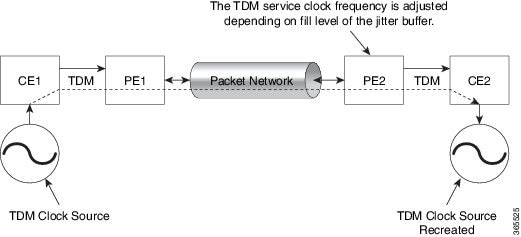Clock Recovery
System
The Clock Recovery System recovers the service clock using Adaptive Clock Recovery (ACR) and Differential Clock Recovery (DCR).
- Finding Feature Information
- Information About Clock Recovery
- Prerequisites for Clock Recovery
- Restrictions for Clock Recovery
- How to Configure ACR and DCR
- Additional References for Clock Recovery
Finding Feature Information
Your software release may not support all the features documented in this module. For the latest caveats and feature information, see Bug Search Tool and the release notes for your platform and software release. To find information about the features documented in this module, and to see a list of the releases in which each feature is supported, see the feature information table.
Use Cisco Feature Navigator to find information about platform support and Cisco software image support. To access Cisco Feature Navigator, go to www.cisco.com/go/cfn. An account on Cisco.com is not required.
Information About Clock Recovery
Adaptive Clock Recovery (ACR)
Adaptive Clock Recovery is most commonly used for Circuit Emulation (CEM). ACR is an averaging process that negates the effect of random packet delay variation and captures the average rate of transmission of the original bit stream. ACR recovers the original clock for a synchronous data stream from the actual payload of the data stream. In other words, a synchronous clock is derived from an asynchronous packet stream. ACR (Adaptive Clock Recovery) is a technique where the clock from the TDM domain is mapped through the packet domain.

Differential Clock Recovery (DCR)
Differential Clock Recovery (DCR) is another technique used for Circuit Emulation (CEM) to recover clocks based on the difference between PE clocks. TDM clock frequency are tuned to receive differential timing messages from the sending end to the receiving end. A traceable clock is used at each end, which ensures the recovered clock is not affected by packet transfer.

Benefits of Clock Recovery
Scaling Information
|
IM Card |
Pseudowires Supported (Number of Clocks Derived) |
|---|---|
|
DS1 |
48 |
|
DS3 |
1344 |
|
OC-192 Interface Module or 8-port Low Rate CEM Interface Module (10G HO / 10G LO) |
2000 |
Prerequisites for Clock Recovery
Restrictions for Clock Recovery
How to Configure ACR and DCR
Configuring ACR for T3
Configuring Adaptive Clock Recovery of T3 Interfaces for SAToP
Before You Begin
-
The node (router) on which the DS3 is configured for ACR, must have its own clock derived from BITS/GPS/Stratum clock.
-
The minimum packet size of CEM pseudowires on the network that delivers robust clock recovery is 256 bytes.
enable configure terminal controller t3 0/0/1 cem-group 0 unframed clock source recovered 1 exit
recovered-clock 0 0 clock recovered 1 adaptive cem 1 0 exit
 Note | The clock configuration on controller must be done before configuring the clock recovery on global configuration mode. |
Verifying Adaptive Clock Recovery Configuration of T3 Interfaces for SAToP
Router# show recovered-clock Recovered clock status for subslot 0/4 --------------------------------------- Clock Type Mode CEM Status Frequency Offset(ppb) Circuit-No 0 DS3 ADAPTIVE 0 ACQUIRED n/a 0 (Port)
Router# show running-config | section 0/0/1 controller MediaType 0/0/1 mode t3 controller T3 0/0/1 cem-group 0 unframed clock source recovered 1 cablelength 224 interface CEM0/0/1 no ip address cem 0
Router# show running-config | section recovered-clock recovered-clock 0 0 clock recovered 1 adaptive cem 1 0
Configuring DCR for T3
Configuring Differential Clock Recovery of T3 Interfaces for SAToP
Before You Begin
-
Before you start configuring DCR, RTP must be enabled on the CEM interface. The RTP is used to carry the differential time.
-
The minimum packet size of CEM pseudowires on the network that delivers robust clock recovery is 256 bytes.
To configure Differential clock recovery on T3 interfaces for SAToP in controller mode, use the following commands:
enable configure terminal controller t3 0/0/1 cem-group 0 unframed clock source recovered 1 exit
To configure RTP header under interfaces, use the following commands:
interface cem 0/0/1 cem 0 rtp-present
To configure Differential clock recovery of T3 interfaces in global configuration mode, use the following commands:
recovered-clock 0 0 clock recovered 1 differential cem 1 0 exit
 Note | The clock configuration on controller must be done before configuring the clock recovery on global configuration mode. |
Verifying the Differential Clock Recovery Configuration of T3 Interfaces for SAToP
Router# show recovered-clock Recovered clock status for subslot 0/4 ---------------------------------------- Clock Type Mode CEM Status Frequency Offset(ppb) Circuit-No 0 DS3 DIFFERENTIAL 0 ACQUIRED n/a 0 (Port)
Router# show running-config | section 0/0/1 controller MediaType 0/0/1 mode t3 controller T3 0/0/1 cem-group 0 unframed clock source recovered 1 cablelength 224 interface CEM0/0/1 no ip address cem 0 rtp-present
Router# show running-config | section recovered-clock recovered-clock 0 0 clock recovered 1 differential cem 1 0
Configuring ACR for Channelized T3/T1
Configuring Adaptive Clock Recovery of Channelized T3/T1 Interfaces for SAToP
Before You Begin
-
The node (chassis) on which the T3/T1 is configured for ACR, has to have its own clock derived from BITS/GPS/Stratum clock.
-
The minimum packet size of CEM pseudowires on the network that delivers robust clock recovery is 256 bytes.
enable configure terminal controller t3 0/0/1 t1 1 cem-group 0 unframed t1 1 clock source recovered 1 exit
recovered-clock 0 0 clock recovered 1 adaptive cem 1 0 exit
 Note | The clock configuration on controller must be done before configuring the clock recovery on global configuration mode. |
To remove the clock configuration in ACR and DCR, you must remove the recovery clock configuration in global configuration mode and then remove the controller configuration.
Verifying the Adaptive Clock Recovery Configuration of Channelized T3/T1 Interfaces for SAToP
Router# show recovered-clock Recovered clock status for subslot 0/4 ---------------------------------------- Clock Type Mode CEM Status Frequency Offset(ppb) Circuit-No 0 DS3-ds1 ADAPTIVE 0 ACQUIRED n/a 0/1 (Port/t1)
Router# show running-config | section 0/0/1 controller MediaType 0/0/1 mode t3 controller T3 0/0/1 framing c-bit cablelength 224 t1 1 cem-group 0 unframed t1 1 clock source recovered 1 interface CEM0/0/1 no ip address cem 0
Router# show running-config | section recovered-clock recovered-clock 0 0 clock recovered 1 adaptive cem 1 0
Configuring DCR for Channelized T3/T1
Configuring Differential Clock Recovery of Channelized T3/T1 Interfaces for SAToP
Before You Begin
-
Before you start configuring DCR, RTP must be enabled on the CEM interface. The RTP is used to carry the differential time.
-
The minimum packet size of CEM pseudowires on the network that delivers robust clock recovery is 256 bytes.
enable configure terminal controller t3 0/0/1 t1 1 cem-group 0 unframed t1 1 clock source recovered 1 exit
interface cem 0/0/1 cem 0 rtp-present
recovered-clock 0 0 clock recovered 1 differential cem 1 0 exit
 Note | The clock configuration on controller must be done before configuring the clock recovery on global configuration mode. |
Verifying the Differential Clock Recovery Configuration of Channelized T3/T1 Interfaces for SAToP
Router# show recovered-clock Recovered clock status for subslot 0/4 ---------------------------------------- Clock Type Mode CEM Status Frequency Offset(ppb) Circuit-No 0 DS3-ds1 DIFFERENTIAL 0 ACQUIRED n/a 0/1 (Port/t1)
Router# show running-config | section 0/0/1 controller MediaType 0/0/1 mode t3 controller T3 0/0/1 framing c-bit cablelength 224 t1 1 cem-group 0 unframed t1 1 clock source recovered 1 interface CEM0/0/1 no ip address cem 0 rtp-present
Router# show running-config | section recovered-clock recovered-clock 0 0 clock recovered 1 differential cem 1 0
Additional References for Clock Recovery
Related Documents
|
Related Topic |
Document Title |
|---|---|
|
Cisco IOS commands |
Standards and RFCs
|
Standard/RFC |
Title |
|---|---|
|
ITU -T G.8261 |
Timing and synchronization aspects in packet networks |
MIBs
|
MIB |
MIBs Link |
|---|---|
|
— |
To locate and download MIBs for selected platforms, Cisco IOS releases, and feature sets, use Cisco MIB Locator found at the following URL: |
Technical Assistance
|
Description |
Link |
|---|---|
|
The Cisco Support website provides extensive online resources, including documentation and tools for troubleshooting and resolving technical issues with Cisco products and technologies. To receive security and technical information about your products, you can subscribe to various services, such as the Product Alert Tool (accessed from Field Notices), the Cisco Technical Services Newsletter, and Really Simple Syndication (RSS) Feeds. Access to most tools on the Cisco Support website requires a Cisco.com user ID and password. |
 Feedback
Feedback